OTHERSCIENCE STORIES: Supersonic Vision
Friday , 24, November 2017 Forrest Bishop Otherscience Stories 4 Comments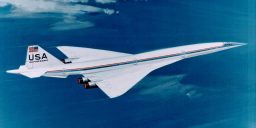
Boeing 2700-300 SST, the SuperSonic Transport
As Fortuna would have it, I found myself excavating the ancient remains of the SuperSonic Transport the other day. I used the usual techniques any archeologist would recognize, carefully brushing off the accumulated detritus between the ribs, there along the stringers, and there in the memory. There was something else in there as well, between the flush rivets, around the tack-welded sine-wave webbing- a ghost in the machine.
Way back when, Everyman would line up to tour this massive, exotic new flying machine. Supersonic turbojets would drive its titanium-alloy frame at 1800 MPH through the outer reaches of the atmosphere, where the stars come out: twice as high and three times faster than the jetliners of their day and of yours. It was a vision not so far removed from a planetary teleportation device. Anyone would be able to afford a ticket to the edge of space on their day trip to London, along with 300 other people. This was not to be; the program was cancelled just as they were about to build the first flying prototypes.
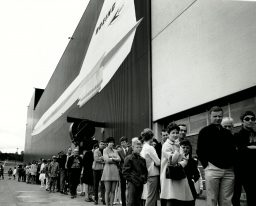
Your grandparents line up to tour the SST mock-up.
Your grandfather dreamed that you would be traveling in flying cars and spaceships to Mars. But today, you are still driving the same old horseless carriage that your grandfather drove. His grandfather could only drive an actual horse. You are flying the same old subsonic jetliner that your grandfather flew. Yet his grandfather thought that flying through the air was a fever dream of madmen.
The past half century of arrested development has lowered expectations so far that Current Year is viewed as Progress. But the basic transportation of [Current Year]! remains lost in 1958, with cell phones and a better paint job. Along with their empires, the dreams they live and die.
Their name was supersonic
The SST was heavier than a 747. At 318 (or 306, or maybe 298) feet, it would have been the longest airplane ever flown. There were other little socialistic supersonic airliners over there back then, but the SST was something else- more bigger, more faster, more heavier, more powerful. More American. It was the other Space Race: the one we lost. The one we forgot.
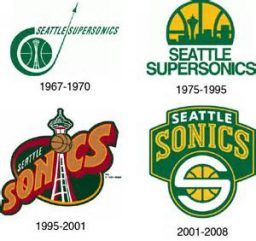
After Boeing won the contract in the 1960’s, a new basketball team was formed in Seattle; its original mascot and namesake was the SST. As part of the forgetting, the SuperSonics became merely the Sonics, breaking through the sound barrier to the downside, then falling off the Space Needle before auguring in a few years later. By the 1990’s, the original reason for the name had been erased from the cultural mythology of the team, a reflection of the story arc of the SST itself.
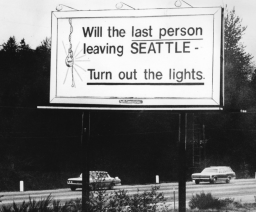
Note 19th C. dinosaur burners
The lights went out on the SST funding on March 31, 1971. Two weeks later the infamous sign went up as a humorous take on the local real estate crash. People were selling their houses in a panic. Amidst a blizzard of pink slips, newspapers ran stories of aerospace engineers working as dishwashers and busboys.
The doom and gloom turned out to be premature. The big airplane company kept building the big airplanes. Other big companies came along having to do with computer something something. But the SST had to go.
Today, there is no SST model offered at the company store. No plastic models of the final design were ever produced (there is a 3D-printer model). The traumatic event led to a collective amnesia, a repressed memory on a national scale.
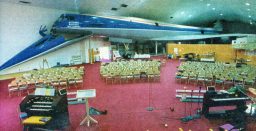
The Florida church of the SST
The SST mockup was ignominiously kicked out of its nest and it flew far away, winding up as the backdrop for a church in Florida, of course. (They botched this story up in the movie adaptation, as Hollywood always does.) After a while, the church needed the space for its growing congregation, and so the poor old SST was kicked out of the nest once again. Unwanted, unloved, all but forgotten, the old bird flew off like a dream into the Floridian wilds and there it cried to itself and even unto its death, alone.
The years swept past and the variegated legends grew, spoken of in fevered whispers and guarded innuendo, imperfectly remembered. In the nihilist’s favorite story, they blew it all up; what remained became a desolate monument of some sort, washed up on the beach. In a different, perhaps more accurate version, rumors moved through stratospheric circles, quiet talk about the carcass of a mysterious, gigantic, prehistoric bird sighted in the unexplored wetlands of La Florida, rotting away.
Acting on these esoteric rumors, a latter-day Ponce de Leon organized an intrepid band of explorers. Fending off alligators, giant snakes, scorpions, and other nasty creatures of the swamp, they bushwhacked their way through the hinterlands in search of.* By the time they tracked it down, the jungle had consumed it all, the way the jungle always does. Only the forlorn, hollowed-out skull and beak remained.
*Parts of this story might be inaccurate. Maybe it was actually crocodiles.
Flight of the SST

The surviving relic of the SST
It is not possible for us to know what a postbellum SST will be like, or even how fast it will fly. There are too many sensitive variables. Any reduction to practice of any one or more of the critical technologies, any alteration in the profitable flight corridors, will affect the final design decisions of a production model. A straightforward evolution would add features like compressor pre-cooling, refractory composites, sonic-boom management, and computer-assisted take off and landing. It wouldn’t need the droop nose.
Our posterity may elect to sweep past the super and go straight for the duper- suborbital, exo-atmospheric aerospacers that can reach any point on the globe, from any other point, in a few dozen minutes. The one thing we can envision about the 21st C. SuperDuper Transport is that it will be even more beautiful, more ascendant, than its ancestors. It shall be glorious.
******
The first SST tour since coming home was on July 21, 2017, at the Museum of Flight Restoration Center. There were at least two older gentlemen in this “Coffee with the Curator” audience who had direct contact with the Boeing SST program. One worked on the “SST Follow On” program in the early 1970’s. The second man spoke to the women at the side table who had shown the old pictures. He said to them (paraphrased):
‘I was a tour guide on this SST mock-up when they had it open to the public. It is my dream to be a tour guide on it again. I hope I can live long enough to do that.’
A fellow came in the day after the meeting. His father was laid off from Boeing in the post-SST economic carnage. He said that was the first time he had ever seen his father cry. As he recounted his story, I thought he was going to cry, too. There is something these gentlemen should know:
We took off for the stars and we stalled. But the runway to success is always paved with failure.
Thanks to you, we will reach for the stars again.
Acknowledgments. Thanks to Boeing Historian and pro tem Museum of Flight Curator Michael Lombardi for background information and images. Thanks to Team Chaplain of the Seattle Sonics Mike Rohrbach for an oral history.
This is the sort of thing I dreamed the Air Force would be full of when I grew up. Something went wrong – instead of supersonic and suborbital transports, we have annual diversity and sensitivity training.
The only problem they couldn’t solve was that it would have burned maybe twice as much fuel per passenger per kilometer as a regular plane.
Karlobot, yes fuel consumption is maybe twice as high. That doesn’t double the ticket price. About 40% of that consumption is for taking off and landing what amounts to a barn door at low speeds. An SST wants to be a shapeshifter- high aspect ratio at low speeds in particular. That’s why the original Boeing design was a swing wing, like a giant F-111. They had to switch to the fixed wing (and eat that fuel cost) after figuring out that the all-titanium swing-wing mechanism would still have been too heavy. They ran up against the square-cube scaling laws.
